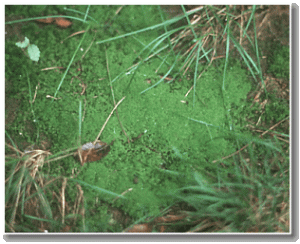Damaged Lawn Repair
Bare Spots Dead Soil
Bare Spots
The most common cause of lawn bare spots is carbon deficiency in the soil and low soil microbial content. These two deficiencies require both “Green” and “Brow” natural organic material.
Natural organic material can be classified into two categories according to their carbon and nitrogen content: Green material and Brown material.
- “Green materials, such as fresh grass clippings, manure and other living plants (weeds) and plant products contain large amounts of nitrogen.
- “Brown” materials such as dried leaves and plants, branches, and woody materials (leaf stems) have high carbon content but are relatively low in nitrogen.
Basically, “Green” materials supply food for the bio-life (bacteria, fungi, and small invertebrates such as worms) which intern manufacture, supply, and facilitate nutrient uptake for the plants. The “Brown” materials provide a home for the “Green” material bio-life.
Top Dressing is mostly “Green” organic material. Organic material when decomposed becomes organic matter at a rate of about 10%. Organic matter is main component of Humus.
Below is a list of some of the benefits when topdressing lawns.
- Top dressing can build up the soil flora. Top dressing adds organic matter to soils.
- Compost top dressing with the right biological components can help reduce lawn diseases.
- Adding compost helps reduce traffic stress.
- Compost incorporated into heavy soils, helps relieve compaction problems.
- Compost incorporated into sandy soils helps with water retention.
- Top dressing with the right materials can help reduce the need for fertilizer.
- Top dressing can help reduce thatch.
- The cation exchange capacity compost is approximately ten times higher than most loam soils.
The best single time of the year for top dressing lawns is in the fall for cool season grasses and in the spring for warm season grasses.
Direct sun on bare areas of your lawn will kill soil microbes. It is recommended you cover the area after treatment with straw until your turf is developed.
“Brown” organic material supplies about 50% of the soil carbon content. Plant roots supply 20-30% during photosynthesis. A healthy lawn requires 5-6% carbon content in the soil. Most South Carolina lawns have at best a 2% carbon content. Mulched dried leaves and plant matter is an excellent source of “Brown” organic material.
Dead Soil
Dead Soil
The most common cause of dead lawn soil is over and prolonged use of chemical and synthetic fertilizers, herbicides and insecticides. The uses of these have killed off the soil bio-life. These areas must be detoxified. High salt content left by non-organic fertilizers must also be neutralized.
I have found a 5:1 mixture of liquid humic acid and a liquid aerifying agent supplemented with liquid cold sea kelp and natural molasses to be very successful. Two ounces of this solution per gallon of water per 1,000 sq. ft of lawn is adequate unless you have a chlorinated water source. For a chlorinated water source, the mixture needs to be 6:1. Apply another treatment after 2 days and them every 6 weeks. I use Nature’s Magic mixed with Aerify for this treatment and for whole lawn health maintenance twice a year. I use Nature’s Magic every 5-6 weeks alone the rest of the time. I also use a bio-enhanced dethatcher in early spring and again in the fall.
For a healthy, disease and insect free lawn, you should NOT use synthetic or chemical fertilizers, herbicides or insecticides. Organic lawn care is safe for people, pets, and the environment. It’s also cheaper in the long run.
Steve












